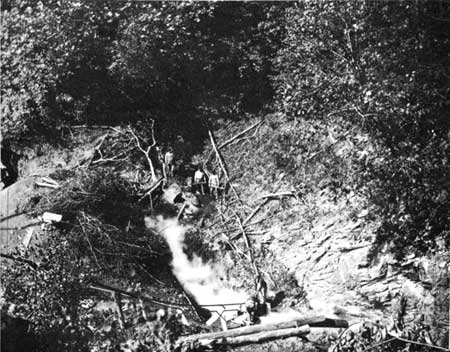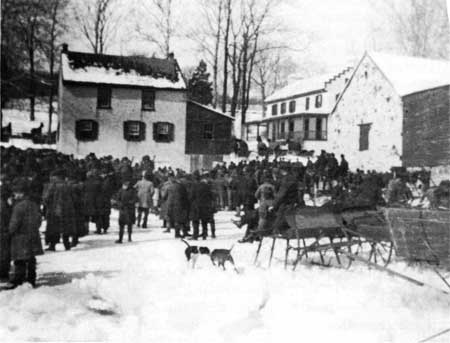|
HOPEWELL VILLAGE National Historic Site |
 |

Hopewell "mine hole" near Warwick. Practically all early mines
were open pits, the rich veins of ore lying near the surface. Shaft
mining did not become general until well into the nineteenth century.
Courtesy Chester County Historical Society.
Hopewell's Decline
The depression of 1837, coupled with the successful introduction of the hot-blast method in the smelting of iron in the following year, making possible the substitution of coke for charcoal, spelt the doom of the charcoal-burning furnace. Thus, of the more than 100 ironworks built in Pennsylvania during the eighteenth century, most of which survived into the beginning of the nineteenth, only 12 were left by 1850. The number of anthracite furnaces in that year was 286. Hopewell managed to survive, but its days were numbered. By 1845, finished castings on a commercial scale were discontinued, as competition was too one-sided. Thereafter, the furnace concentrated on pig iron for which there was still a ready market. Some improvements were effected in the late 1840's which raised the average daily output to 3 tons by 1853. It was in that year, in fact, that Hopewell achieved its best record of pig iron produced, 1,205 tons. That the old furnace could not survive long, however, was clear to the owners, for in 1849 they erected nearby an experimental anthracite furnace. It was hoped that this new furnace would replace the old one. But the cost of bringing in anthracite coal was too great, and after a few years the experiment was given up as a bad investment.
The old charcoal burner continued operating, however, and in 1857 even produced 1,094 tons, the third highest record. This was the fourth and last time it made over 1,000 tons in any one blast. From then on the story is one of decline, or, at best, of just hanging on. Even the war years, contrary to local tradition, with pig iron selling at as high as $99 per ton, did not make much difference. The best Hopewell could produce was 933-1/2 tons in 1861. An important reason for this, no doubt, was the fact that by that time the best ore deposits in the vicinity had been used up, and the remaining ore, high in sulfur and other impurities, did not yield as much per ton.

Winter scene in Hopewell Village in the early
nineties. After 1883, when the furnace closed down, the woodland
surrounding Hopewell continued to make good returns from charcoal
production for several years.
Courtesy Chester County Historical
Society.
From 1870 to 1883, almost the entire furnace output went to A. Whitney & Sons, the big car wheel manufacturers of Philadelphia, and it is not improbable that Hopewell iron has rolled over several of America's transcontinental railroads. But the postwar picture was generally drab, for it was evident that Hopewell had outlived its era. Cold statistics plainly reveal that industrially it could not even match its own prewar record, let alone compete with newer processes. In social aspects, plantation life had lost much of its earlier character, its quaintness, simplicity, and even charm.
One last effort was made to keep the furnace going by making improvements. A steam boiler was installed in 1880 to provide auxiliary power for the water wheel (fueled by gas from the furnace it was the one modernization "suffered" by the furnace); and an ore roaster, in 1882, was added to calcine ore. The water wheel was substantially rebuilt, and the old receiver of the blast equipment was replaced by a larger one. All this was to little avail, however, for in 1883 the furnace was blown out for the last time.
Hopewell was one of the last of the old cold-blast, charcoal-burning furnaces. Owing to many favorable circumstances, it continued in operation long after most of its kind had been supplanted by more modern methods and plants.

|
|
Last Modified: Mon, Dec 2 2002 10:00:00 am PDT |


